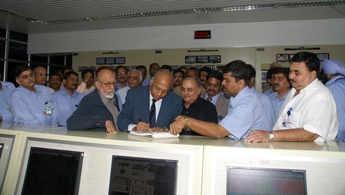India's Kaiga unit 4 achieved criticality on 27 November. The unit will be synchronized to the southern grid after carrying out tests in early December.

KGS-4, like its predecessors – KGS-1, 2 and 3 that are in operation – is an indigenous Pressurized Heavy Water Reactor (PHWR) of 220 MW and is fuelled with the uranium sourced from domestic mines.
With Kaiga 4 becoming operational, India is now the sixth nation in the world, after USA, France, Japan, Russian Federation and Republic of Korea, to have twenty or more nuclear power reactors currently in operation.
The electricity generated from this unit will be supplied to the beneficiary states – Karnataka, Tamil Nadu, Kerala, Andhra Pradesh and Pudducherry.
Kaiga 4 is the NPCIL’s third nuclear power reactor after RAPS 5 & 6, to have started operation during the current year, raising the nuclear installed capacity in the country from the current 4560 MW to 4780 MW.
Currently, two Light Water Reactors (LWRs), each of 1000 MW at a Kudankulam as well as a Prototype Fast Breeder Reactor (PFBR) of 500 MW at Kalpakkam are at advanced stages of completion. In addition, four indigenously designed 700-MW PHWRs, two each at Kakrapar in Gujarat and Rawatbhata in Rajasthan, are due to start construction during the current year.
The installed nuclear power capacity on progressive completion of the reactors under construction will reach 7280 MW and 10080 MW by the year 2012 and 2017, respectively. NPCIL’s vision is to reach 20000 MW or more by the year 2020 and play a major role in reaching country’s installed nuclear power capacity of 63000 MW by 2032 by setting up indigenously designed 700 MW PHWRs and 1000 MW or larger size Light Water Reactors (LWRs).
NPCIL has started pre-project activities at two inland sites for setting up indigenous 700-MW PHWRs in Haryana, MP and three coastal sites to set up 1000-MW or larger-size LWRs, based on international technical cooperation, in Gujarat, Andhra Pradesh and West Bengal.
NPCIL is unique in having comprehensive capabilities in the various facets of nuclear technology, namely, site selection, design, construction, commissioning, operation and maintenance, renovation and modernization, and life extension of nuclear power plants.
Related ArticlesNuclear safety evolves in India




